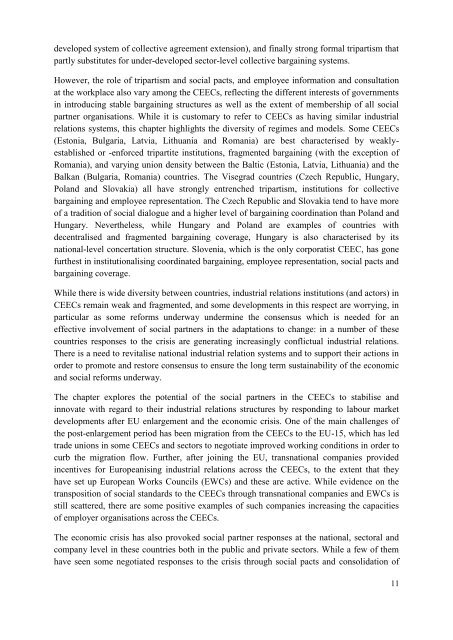Industrial Relations in Europe 2012 - European Commission - Europa
Industrial Relations in Europe 2012 - European Commission - Europa
Industrial Relations in Europe 2012 - European Commission - Europa
You also want an ePaper? Increase the reach of your titles
YUMPU automatically turns print PDFs into web optimized ePapers that Google loves.
developed system of collective agreement extension), and f<strong>in</strong>ally strong formal tripartism that<br />
partly substitutes for under-developed sector-level collective barga<strong>in</strong><strong>in</strong>g systems.<br />
However, the role of tripartism and social pacts, and employee <strong>in</strong>formation and consultation<br />
at the workplace also vary among the CEECs, reflect<strong>in</strong>g the different <strong>in</strong>terests of governments<br />
<strong>in</strong> <strong>in</strong>troduc<strong>in</strong>g stable barga<strong>in</strong><strong>in</strong>g structures as well as the extent of membership of all social<br />
partner organisations. While it is customary to refer to CEECs as hav<strong>in</strong>g similar <strong>in</strong>dustrial<br />
relations systems, this chapter highlights the diversity of regimes and models. Some CEECs<br />
(Estonia, Bulgaria, Latvia, Lithuania and Romania) are best characterised by weaklyestablished<br />
or -enforced tripartite <strong>in</strong>stitutions, fragmented barga<strong>in</strong><strong>in</strong>g (with the exception of<br />
Romania), and vary<strong>in</strong>g union density between the Baltic (Estonia, Latvia, Lithuania) and the<br />
Balkan (Bulgaria, Romania) countries. The Visegrad countries (Czech Republic, Hungary,<br />
Poland and Slovakia) all have strongly entrenched tripartism, <strong>in</strong>stitutions for collective<br />
barga<strong>in</strong><strong>in</strong>g and employee representation. The Czech Republic and Slovakia tend to have more<br />
of a tradition of social dialogue and a higher level of barga<strong>in</strong><strong>in</strong>g coord<strong>in</strong>ation than Poland and<br />
Hungary. Nevertheless, while Hungary and Poland are examples of countries with<br />
decentralised and fragmented barga<strong>in</strong><strong>in</strong>g coverage, Hungary is also characterised by its<br />
national-level concertation structure. Slovenia, which is the only corporatist CEEC, has gone<br />
furthest <strong>in</strong> <strong>in</strong>stitutionalis<strong>in</strong>g coord<strong>in</strong>ated barga<strong>in</strong><strong>in</strong>g, employee representation, social pacts and<br />
barga<strong>in</strong><strong>in</strong>g coverage.<br />
While there is wide diversity between countries, <strong>in</strong>dustrial relations <strong>in</strong>stitutions (and actors) <strong>in</strong><br />
CEECs rema<strong>in</strong> weak and fragmented, and some developments <strong>in</strong> this respect are worry<strong>in</strong>g, <strong>in</strong><br />
particular as some reforms underway underm<strong>in</strong>e the consensus which is needed for an<br />
effective <strong>in</strong>volvement of social partners <strong>in</strong> the adaptations to change: <strong>in</strong> a number of these<br />
countries responses to the crisis are generat<strong>in</strong>g <strong>in</strong>creas<strong>in</strong>gly conflictual <strong>in</strong>dustrial relations.<br />
There is a need to revitalise national <strong>in</strong>dustrial relation systems and to support their actions <strong>in</strong><br />
order to promote and restore consensus to ensure the long term susta<strong>in</strong>ability of the economic<br />
and social reforms underway.<br />
The chapter explores the potential of the social partners <strong>in</strong> the CEECs to stabilise and<br />
<strong>in</strong>novate with regard to their <strong>in</strong>dustrial relations structures by respond<strong>in</strong>g to labour market<br />
developments after EU enlargement and the economic crisis. One of the ma<strong>in</strong> challenges of<br />
the post-enlargement period has been migration from the CEECs to the EU-15, which has led<br />
trade unions <strong>in</strong> some CEECs and sectors to negotiate improved work<strong>in</strong>g conditions <strong>in</strong> order to<br />
curb the migration flow. Further, after jo<strong>in</strong><strong>in</strong>g the EU, transnational companies provided<br />
<strong>in</strong>centives for <strong>Europe</strong>anis<strong>in</strong>g <strong>in</strong>dustrial relations across the CEECs, to the extent that they<br />
have set up <strong>Europe</strong>an Works Councils (EWCs) and these are active. While evidence on the<br />
transposition of social standards to the CEECs through transnational companies and EWCs is<br />
still scattered, there are some positive examples of such companies <strong>in</strong>creas<strong>in</strong>g the capacities<br />
of employer organisations across the CEECs.<br />
The economic crisis has also provoked social partner responses at the national, sectoral and<br />
company level <strong>in</strong> these countries both <strong>in</strong> the public and private sectors. While a few of them<br />
have seen some negotiated responses to the crisis through social pacts and consolidation of<br />
11

















